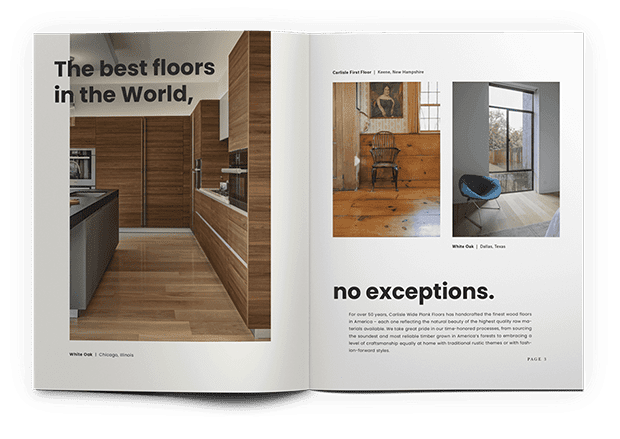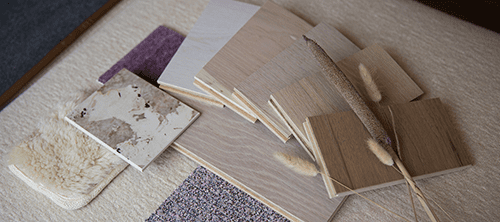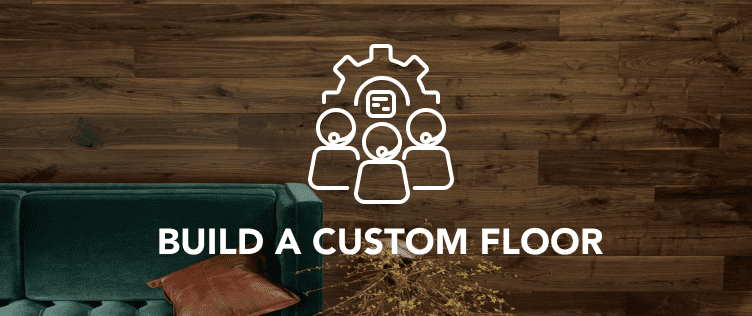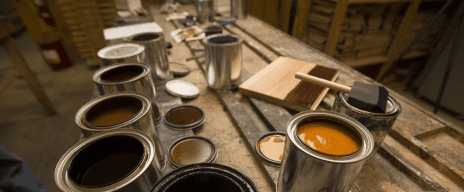Download our wood flooring buyer’s guide for helpful advice on how to choose and shop for wood flooring. Learn why wood is the superior flooring choice while exploring wood species, style, colors and textures. Understand durability, performance, installation options and more.
3 Signs Moisture is Under Your Hardwood Floors

A polished, sophisticated hardwood floor is the focal point of any home. With proper care, an artisan hardwood floor can be a beautiful feature of any home for decades, if not generations. Whether your planks are filled with striking, organic knots or an elegantly simple finish, keeping your floors protected is a top priority—and the biggest culprit to watch out for is moisture.
You can do many things to prevent moisture from damaging your hardwood floors, but sometimes water damage is unavoidable. Knowing the signs of moisture under your hardwood floors can help you take swift action and keep your floors healthy, functional, and beautiful for years to come.
Why is Moisture Bad For Wood Floors?
Although hardwood floors are solid and resilient, wood is still a naturally porous material. This means that air and moisture can move through and penetrate the wood to a certain degree. To guard against this, wood is treated, finished, and sealed prior to or just after the hardwood floor installation process. Both natural and engineered hardwood floors are susceptible to this type of moisture damage.

Endless Inspiration for the Floor of Your Dreams
GET DESIGN BOOK3 Common Signs of Moisture Damage in Hardwood Floors
Cupping Hardwood Floors
 One of the most common signs of moisture damage in hardwood floors is cupping. Cupping is when the boards expand across the face and create sufficient pressure at the edge where the boards meet that the planks curl, or rise at the seams between the boards This can happen for multiple reasons. First if the relative humidity in the home becomes excessive the boards will absorb this moisture and eventually expand. Second, if the subfloor, crawl space or basement are excessively wet the moisture will eventually penetrate the bottom of the boards resulting in excessive expansion.. Not only does this harm the aesthetics of your flat floor, but it can also cause structural damage if left unaddressed. Severe cupping can cause gaps between floorboards. If the cupping is severe enough, the wood won’t be able to return to its original shape and will need to be replaced.
One of the most common signs of moisture damage in hardwood floors is cupping. Cupping is when the boards expand across the face and create sufficient pressure at the edge where the boards meet that the planks curl, or rise at the seams between the boards This can happen for multiple reasons. First if the relative humidity in the home becomes excessive the boards will absorb this moisture and eventually expand. Second, if the subfloor, crawl space or basement are excessively wet the moisture will eventually penetrate the bottom of the boards resulting in excessive expansion.. Not only does this harm the aesthetics of your flat floor, but it can also cause structural damage if left unaddressed. Severe cupping can cause gaps between floorboards. If the cupping is severe enough, the wood won’t be able to return to its original shape and will need to be replaced.
Crowning Hardwood Floors
 Crowning is the inverse of cupping. When excess moisture is absorbed into the floorboard, the center of a floorboard can rise or swell above the edges. This also results in an uneven floor and, if left untreated, can cause long-term damage to the integrity of your hardwood floors.
Crowning is the inverse of cupping. When excess moisture is absorbed into the floorboard, the center of a floorboard can rise or swell above the edges. This also results in an uneven floor and, if left untreated, can cause long-term damage to the integrity of your hardwood floors.
Warping, Buckling, or Sagging Hardwood Floors
If cupping or crowning floors are left unrepaired, they can often result in warping, buckling, or sagging floors as the floorboards separate from your subfloor or support beams deteriorate. This is the most severe form of water damage and will likely require repairs or even replacing the flooring.
How to Treat Moisture Under Hardwood Floors

If you suspect your floors are being harmed by excess moisture or water damage, the first step is to investigate the source of the moisture. If the moisture levels are low and temporary—for instance, a small leak that’s already been fixed—then using a dehumidifier can often treat the issue. First, wipe up any visible water on or around the flows, then set up a dehumidifier (or two) and a fan to help circulate air and dry out the boards.
Don’t immediately panic if you think the damage might be more significant. As moisture soaks through the wood floor, it can cause some movement and uneven planks. As the floor dries, though, it can sometimes lay flat again. So wait until the floor is fully dried before assessing the level of damage.
The worst-case scenario for hardwood floors is if the moisture source can’t be addressed or the damage has become too severe. If that’s the case, the floor will need to be removed to eliminate the source of moisture. Then, it’s time to rebuild. Have your flooring professionals install a heavier vapor barrier to prevent future issues.
FAQs: Moisture Under Hardwood Floors
How do I get rid of moisture under my floor?
Your first step to getting rid of moisture under your floor should be to identify the source of the water and stop any future moisture from affecting your floors. Mop up any standing or visible water, and then use dehumidifiers and fans to help dry out the floors. At that point, you—or a flooring professional—can evaluate the extent of the damage and figure out the right next steps.
Can water damaged wood floors be fixed?
Depending on the level of water damage, wood floors can often be restored. Wood floors are very durable and long-lasting. If your hardwood floors have water damage, they can often be repaired by replacing the affected floorboards and then sanding and refinishing the repaired areas to match the existing floor. In severe cases of water damage, the entire hardwood floor may need to be replaced. If you suspect your floors have serious water damage, it’s always good to work with a hardwood floor expert as they can help you make an informed decision about your options.





